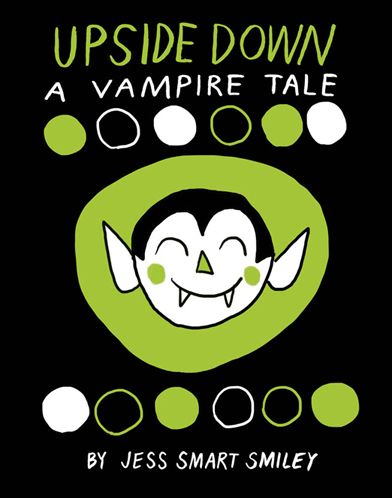Trick or treat? Jess Smart Smiley's Upside Down is definitely a treat, and if there's anything at all deceptive about his new graphic novel, it's how charming the simple, even roughshod-looking artwork ultimately is, and, perhaps, how far he strays from pop-culture conventions into his own idiosyncratic monster mythology.
Part of Top Shelf's growing line of kid-friendly comics, this original graphic novel is a black, white and "Halloween green"-colored story about Harold, a young vampire that loves candy and lives in a piano with his parents. This piano belongs to an eccentric professor, who has been tirelessly working on a potion that will allow a person live forever.
At story's start, Harold is on his way to the dentist to get his teeth looked at on the day before he is finally old enough to join his parents on a "hunt," but ultimately has to have his fangs pulled, due to cavities. A wicked witch named Vermillion attempts to rally the last remaining witches on Earth, only to accidentally kill them all with a rain spell, making her the last witch on earth. And the professor perfects his potion, which is suddenly of great interest to Vermillion, now that she's the last witch.
These characters and a few others crisscross conflicts throughout the book's 15o-ish pages, those crisscrosses coming in some rather unexpected ways (in the world of Upside Down, for example, vampires don't hunt people to suck their blood, they hunt witches, and witches can turn other people into witches, even vampires, using spells).
The sense that Smiley's making it up as he's going along, even if the tight plotting assures that he's not actually doing so, gives the book its own, unique energy signature; it has sort of dreamy quality, like a story being told by a child, and feels much more like that than one being told to a child.
Smiley's art, at first blush, looks an awful lot like that of the "my kid could draw that" variety, although if you've ever spent much time trying to draw, you ealize how hard such art is to actually produce, let alone to do so consistently from panel to panel.
The designs are definitely simple, though, and the lines of Smiley's panels, seemingly done freehand, give the book a homemade, look rather than something produced with machine-like precision. Were it not for the color, it would look very much like something you might find in an artist's sketchbook.
The one aspect I found troubling was his design for Harold when Harold was transformed into a bat ... and he spends much of the book in bat-mode (the vampire family are bats when they hang out in the professor's piano, and, when he loses his fangs, Harold decides to run away and try to live as a bat among bats for a while, as he doesn't think he can go on vampiring). You can see it, and the first nine pages of the book, at the preview available here. Unlike his parents when they are in bat-mode, and unlike the pair of bats he befriends, Harold has a long, pointy snout when he's a bat, which resembles a beak. And because he's always drawn in profile, with his two bat ears both simultaneously visible, they look like a rooster comb, making him look like a big, black chicken.
I obsessed over his design the first two times I read the book, and now that I go back and look at it again, I still can't figure out exactly why he's drawn like that. Combined with his long, duck-like neck, it certainly makes him look distinct from the other bats, allowing one to keep an eye on him during multi-bat scenes, but he still looks like a bird more than a bat.
The book ends with sketches for Book Two, A Hatful of Spells, which will apparently involve a cat and the return of Vermillion. No word on exactly when the second book will come out, but I wouldn't be surprised if it's next October. 'Tis the season, after all.


